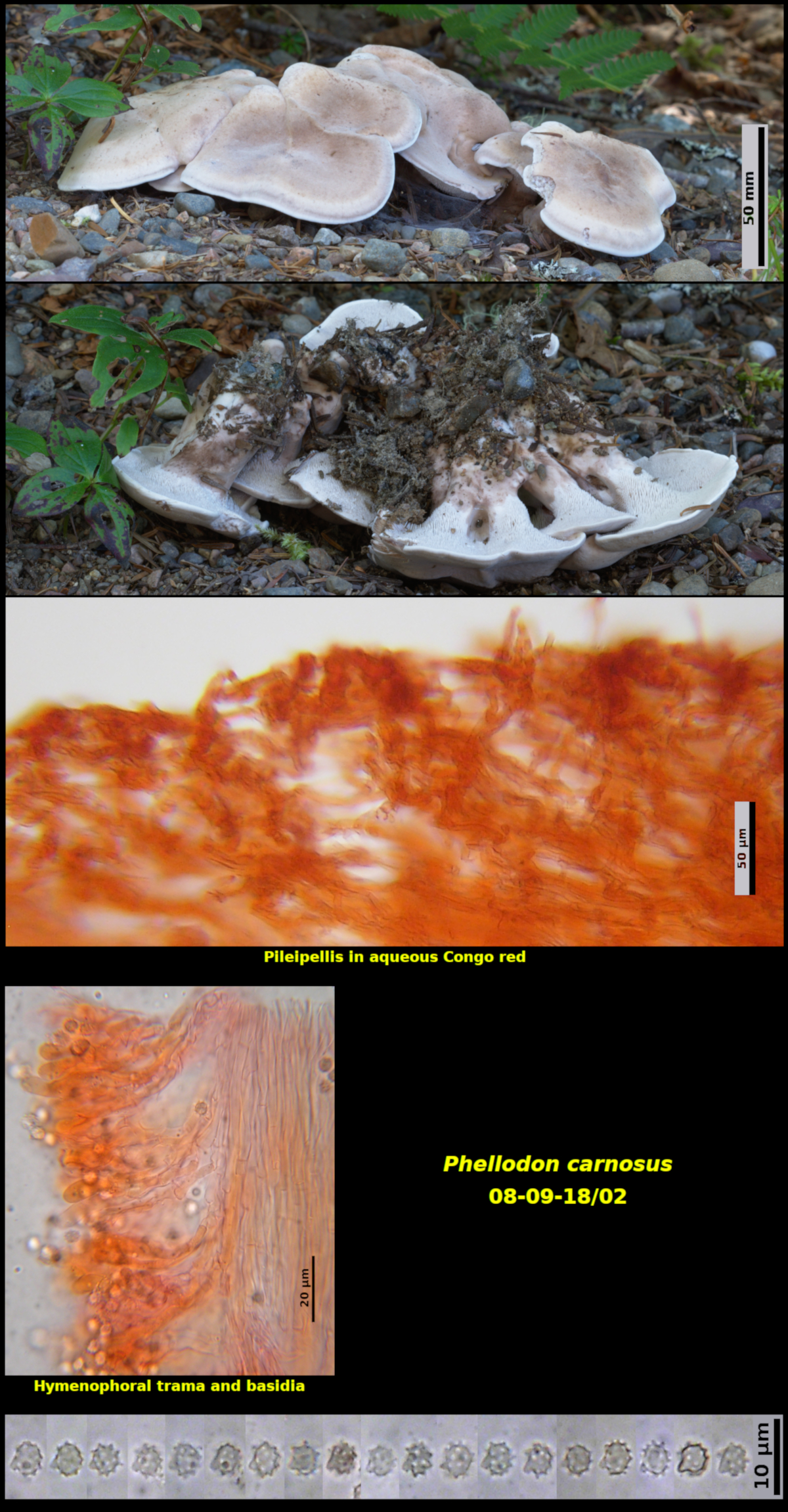Fleshy Fungi of New Brunswick >>
Phellodon carnosus
Phellodon carnosus Banker

Gregarious (many) in a dense mass or solitary at the margin of gravel driveway, associated with Abies balsamea, Little Lepreau, New Brunswick (08-09-18/02).
Basidiospores white in spore print, broadly ellipsoidal to subglobose, echinulate, with spines up to 1 μm high, with a prominent apiculus, 3.5-4.2 x 2.7-3.6 μm, Q = 1.05-1.35 (average[35]: 3.8 x 3.1 μm, Q = 1.20) – measurements made without including spines or apiculus. Basidia narrowly clavate, 4-spored. Pileipellis a cutis hardly differentiated from the pileal trama when young, later becoming loosened and more interwoven. Hymenophoral trama parallel, giving rise to clusters of basidia, without a differentiated subhymenium. Clamp connections lacking throughout.
This large tan to grey-brown mushroom with basidia borne on long teeth is common in our region and easy to recognize. When the basidiomata are first collected the odour is faintly reminiscent of imitation maple flavouring, a smell recognizable to all Canadians as that of the familiar maple-leaf-shaped cookies. When dried this odour becomes much stronger and will fill a room when a bag of the mushrooms is opened. The tiny basidiospores covered with sharp spines are also characteristic.
Phellodon carnosus was described by Banker (Mycologia 5: 62-66. 1913.) to accommodate two collections growing under conifers in New York state and Vermont. Banker pointed out the more fleshy consistency of the basidiomata compared to those of most other Phellodon species. The name was taken up by Coker & Beers (The stipitate hydnums of the eastern United States. Univ. N. Carolina Press, Chapel Hill. 1951.), who added an additional collection from North Carolina. It was later transferred to the genus Bankera by Snell, E.A. Dick & Taussig. Baird et al. (Fungal Diversity 62: 41-114. 2013) more recently, using ITS sequences, argued that Bankera should be included in Phellodon.
Later authors have doubted the distinctiveness of P. carnosa, including it under synonymy of P. molle or P. violascens, both names typified by European material. K.A. Harrison (The stipitate hydnums of Nova Scotia. Canada Dept. of Agriculture Publ. 1099, Ottawa. 1961.) made numerous collections in Nova Scotia of a fungus he assigned to Bankera carnosa and compared it with Phellodon fuligineoalbus (as Bankera fuligineoalba), also abundant in Nova Scotia.
Collections of P. carnosus (or P. violascens) from North America are well represented in herbaria, especially ACAD, but have rarely been compared genetically with European collections. The one exception being a collection from Quebec (GenBank KM406977), which has a rather low congruence of ITS sequences (maximum 97.35%) with several European collections of P. violascens. It appears to be even less closely related to other species of Phellodon. This suggests that Harrison was correct in using the name P. carnosus rather than one of the European names. Furthermore, P. violascens in Europe is described as having the flesh whitish to lilaceous grey in the pileus and reddish to purplish in the stipe. North American collections appear to lack these colours. Nikolaeva (Hydnaceae Fungi. Izdatel'stvo Akademii Nauk, USSR. 1961 (English translation published by USDA, 1977)) discusses this species in some detail and stresses the violet colours, particularly those on the scales of young pilei.
Most accounts of P. carnosus in North America do not record its association with pines, which seems to be a constant feature of the related species P. fuligineoalbus. The three collection from New Brunswick in NBM are all from near Little Lepreau, an area on the coast of the Bay of Fundy without pines. All three collections had Abies balsamea or Picea rubens present.
Photograph: D. Malloch (08-09-18/02).